I had never heard of Laurent Montaron before last week. I was preparing a trip to Paris and going through the list of exhibitions open when i stumbled upon a small photo of a Catholic saint and, far more interestingly i should say, a press release that mentioned the artist’s interest in the history of media from the appearance of mechanical modes of representation in the late 19th century up to today’s different digital forms.
Off i was to see Montaron’s solo show at the galerie schleicher+lange. The exhibition is small with only three pieces, each of them strong, perplexing and unlike anything i’ve seen anywhere else recently.
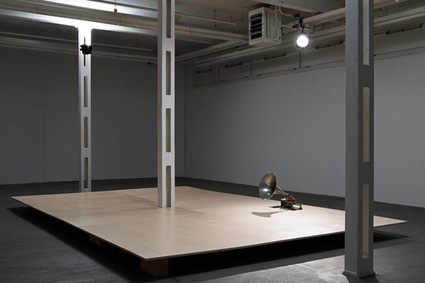 Laurent Montaron, PHOENIX, 2010, phonograph phénix, wood, waxcylinder with recording of a human voice speaking in tongues, installation view Kunsthaus Baselland
Laurent Montaron, PHOENIX, 2010, phonograph phénix, wood, waxcylinder with recording of a human voice speaking in tongues, installation view Kunsthaus Baselland
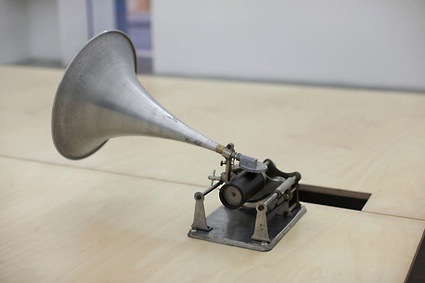 PHOENIX (detail), 2010
PHOENIX (detail), 2010
Phoenix awaits the visitor right as they step into the gallery. An antique Phénix, a wax-cylinder phonograph launched in 1902 by French mail-order company Maleville, is laying on a wooden stage. Someone has to come and activate the phonograph for you. During a few minutes, the time it takes for the needle to go from one end of the cylinder to the other, one can hear the voice of a person speaking in tongues. No sense can be made of what is said in the recording.
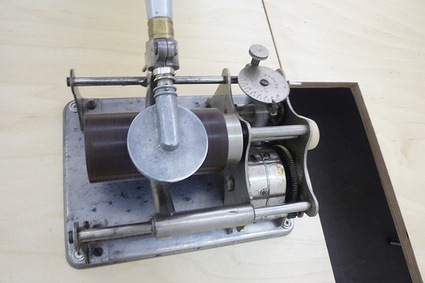 PHOENIX (detail), 2010
PHOENIX (detail), 2010
When he patented the phonograph in 1877, Thomas A. Edison -who ironically was suffering from increasing deafness- wasn’t thinking about musical recordings. He saw the invention as an instrument that would provide a kind of immortality by preserving the human voice well after the person had died. It was a ‘machine to record the last words of the dying’.
“My intention,” the artist has said in an interview with curator Daniel Baumann, “was not only to transform these questions about the advent of the media into images — although I do believe that to some extent the questions are being asked in the same way today as they were a hundred years ago — but also to make the experience of death part of the work. As in a number of my other works, the physical medium is wearing out as we listen and we’re witnessing the death of the sound. In a way the viewer remains the sole repository of the memory of the work.”
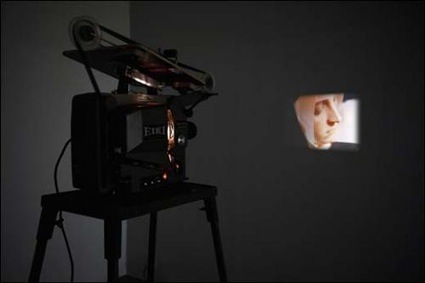 Lent portrait de Sainte Bernadette, 2010
Lent portrait de Sainte Bernadette, 2010
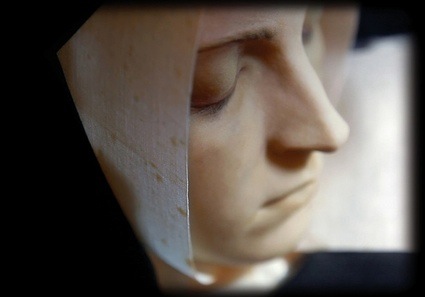 Lent portrait de Sainte Bernadette, 2010
Lent portrait de Sainte Bernadette, 2010
The second work in the exhibition, Lent portrait de Sainte Bernadette (“Slow Portrait of St Bernadette”, 2011), is a slow-motion 16 mm film loop with the camera moving across the face of the saint.
Bernadette Soubirous was a miller’s daughter who made the fortune of a small market town in the SW of France. In 1858, she reported apparitions of “a small young lady” and required that a chapel was built at the site of her visions. The Sanctuary of Our Lady of Lourdes is now a major place of Roman Catholic pilgrimage. It is said that after her death, Bernadette‘s body has shown no signs of decomposition.
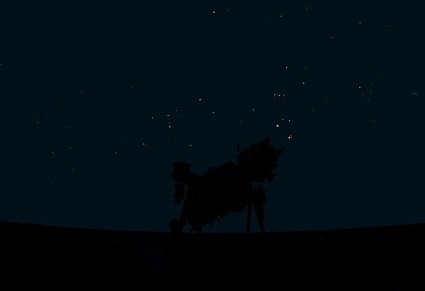 Minolta Planetarium MS-15, 2011
Minolta Planetarium MS-15, 2011
The worked i found most amazing is Minolta Planetarium MS-15, a large-format photograph taken inside the planetarium in Memphis, in the United States. All one can see at first is a starry sky. After a while, the eye wanders and realizes that, in the foreground, there is the dark silhouette of the machine that projects the images of the stars inside the Planetarium.
These works subtly remind us that while technology has provided us with new means of perceiving and representing reality it has not necessarily brought us closer from ‘the truth’ for it has also given rise to new ways for questioning reality.
Laurent Montaron’s work homes in on the paradoxes attendant on our awareness of modernity, and simultaneously on the tools that shape our representations, revealing the sometimes irrational element of belief involved.
The exhibition closes tomorrow. Make haste and visit the galerie schleicher+lange if you’re in Paris this weekend.
